family
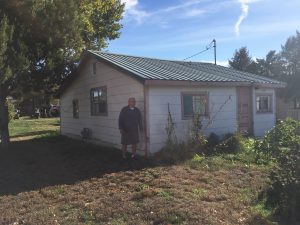
 When you think of a town within a town or city, you often think of New York City, where you might find Queens, Harlem, or Yonkers. Or you might think of New Orleans, where you might find the French Quarter or the 9th Ward, but people really never think of a town within a town, when the town is a small town, like Forsyth, Montana, population of about 1,777. Nevertheless, Forsyth, Montana was a town that had within it a town…so to speak. When my husband, Bob Schulenberg’s grandpa, Andrew Schulenberg was a young married man, he built a couple of houses there. The houses were next door to each other. Andy’s parents lived in one house, and he and his wife, lived in the other. Across the street was another house owned by Schulenberg family relative, Bob’s Great Aunt Hennie. Being such a small town, there were other Schulenberg families very nearby, and since Andy’s parents, Max and Julia Schulenberg had ten children, it made for a lot of Schulenberg relation living in a neighborhood in Forsyth, Montana. Well, before long, the people of the town found themselves calling that neighborhood, Schulenbergville. I’m not sure just exactly when
When you think of a town within a town or city, you often think of New York City, where you might find Queens, Harlem, or Yonkers. Or you might think of New Orleans, where you might find the French Quarter or the 9th Ward, but people really never think of a town within a town, when the town is a small town, like Forsyth, Montana, population of about 1,777. Nevertheless, Forsyth, Montana was a town that had within it a town…so to speak. When my husband, Bob Schulenberg’s grandpa, Andrew Schulenberg was a young married man, he built a couple of houses there. The houses were next door to each other. Andy’s parents lived in one house, and he and his wife, lived in the other. Across the street was another house owned by Schulenberg family relative, Bob’s Great Aunt Hennie. Being such a small town, there were other Schulenberg families very nearby, and since Andy’s parents, Max and Julia Schulenberg had ten children, it made for a lot of Schulenberg relation living in a neighborhood in Forsyth, Montana. Well, before long, the people of the town found themselves calling that neighborhood, Schulenbergville. I’m not sure just exactly when 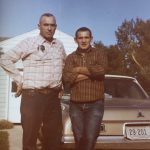 the neighborhood got its name, but since Andy was the sheriff of Rosebud County from 1955 to 1972, my guess is that it was either during that time, or it was his job as sheriff that solidified the name to that area of town.
the neighborhood got its name, but since Andy was the sheriff of Rosebud County from 1955 to 1972, my guess is that it was either during that time, or it was his job as sheriff that solidified the name to that area of town.
I had the chance to see the two houses that Andy Schulenberg built, and to find out that the second one was the house that Bob’s Uncle Butch Schulenberg was born in. I love to see the homes where loved ones were born, partly I suppose, because so few people are born at home these days. In those days, however, being born at home was a very common practice, and it makes me think about the history that the house has witnessed. The house got to see little Butch Schulenberg growing up…or at least starting his life, since I don’t know when the family might have moved out of the house. Nevertheless, the area remained Schulenbergville for a number of years, and I don’t think the locals have forgotten it to this day.
Nor have they forgotten the sheriff who really made the Schulenberg name a household word in the little town of Forsyth. Andy was a different kind of sheriff from those you normally meet, and that is a story I will tell sometime, but it’s too long for this story. Suffice it to say that he was dearly loved, and there is more than one 
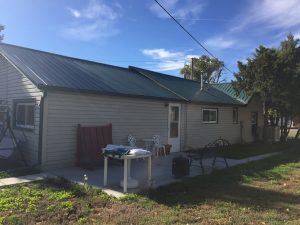 adult who owes the fact that they weren’t in prison…or worse as kids, to Sheriff Andy Schulenberg, and they will be happy to tell you so. The two houses Andy built still stand, as do the houses of the neighboring Schulenberg clan members, although some are no longer occupied. I find that a bit sad, but it is a testament to good construction work. Now they stand as a treasured memory for those who knew Schulenbergville well.
adult who owes the fact that they weren’t in prison…or worse as kids, to Sheriff Andy Schulenberg, and they will be happy to tell you so. The two houses Andy built still stand, as do the houses of the neighboring Schulenberg clan members, although some are no longer occupied. I find that a bit sad, but it is a testament to good construction work. Now they stand as a treasured memory for those who knew Schulenbergville well.

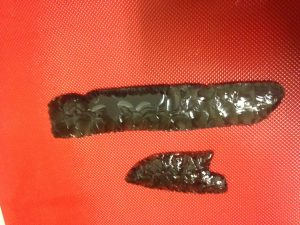 When you think of Indian arrowheads, you usually think of the Old West or the cowboys and Indians. You think of the battles the Indians had over broken treaties and the influx of settlers into the west. That’s what you think of, but that isn’t what my nephew, Steve Moore thinks of…at least that’s not the only thing he thinks about. For Steve, thoughts of arrowheads bring thoughts of obsidian.
When you think of Indian arrowheads, you usually think of the Old West or the cowboys and Indians. You think of the battles the Indians had over broken treaties and the influx of settlers into the west. That’s what you think of, but that isn’t what my nephew, Steve Moore thinks of…at least that’s not the only thing he thinks about. For Steve, thoughts of arrowheads bring thoughts of obsidian.
You might think that is strange, but Steve has learned the ancient art of flintknap. It all started with his love of wall climbing. He learned to make the hand and foot holds for wall climbing. Then, he started thinking about flintknap. Flintknap is the art of making arrowheads and other weapons from rocks, like obsidian. Steve started 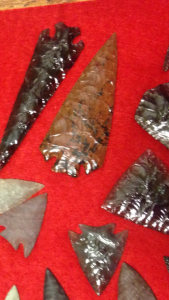 with pieces of broken glass, and later graduated to rocks, and even bone. He and a friend named Scott, made a trip to Oregon and brought back a truck load of obsidian, and Steve taught Scott and another friend, Jay how to flintknap. Steve, made some amazing tools to knap with.
with pieces of broken glass, and later graduated to rocks, and even bone. He and a friend named Scott, made a trip to Oregon and brought back a truck load of obsidian, and Steve taught Scott and another friend, Jay how to flintknap. Steve, made some amazing tools to knap with.
Through the years, Steve got out of the flintknapping hobby for a time…twelve years or so, but has recently picked it up again. Flintknapping is a great hobby to engage in while sitting around the campfire or the fireplace in the evenings. Steve made two arrowheads each weekend these past two weekends. His wife, my niece, Machelle told me that when you are flintknapping, you have to learn how not to bleed. If Steve gets that talent accomplished, I know several people who would like to know the trick to it.
Steve likes obsidian the best, because it creates beautiful shine and color to the arrowheads and other weapons. The rainbow obsidian is one of Steve and Machelle’s favorites because of the beautiful colors it contains. The orange of the pumpkin obsidian is also stunning. When I looked at the pictures that Machelle sent me of Steve’s work, it felt like I was looking at jewels. The arrowheads sparkle and shine, almost like 
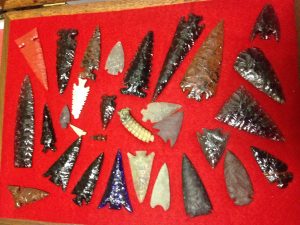 diamonds. I was stunned to find that Steve had such a talent, but then it’s pretty typical of Steve not to blow his own horn. That just isn’t his style, so I guess I’ll just do it for him, because as far as I’m concerned, Steve has an amazing talent. These arrowheads and weapons, while functional if they ever needed ammunition, are so much more than that. They are absolutely beautiful. Today is Steve’s birthday. Happy birthday Steve!! Have a great day!! We love you!!
diamonds. I was stunned to find that Steve had such a talent, but then it’s pretty typical of Steve not to blow his own horn. That just isn’t his style, so I guess I’ll just do it for him, because as far as I’m concerned, Steve has an amazing talent. These arrowheads and weapons, while functional if they ever needed ammunition, are so much more than that. They are absolutely beautiful. Today is Steve’s birthday. Happy birthday Steve!! Have a great day!! We love you!!
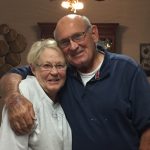 It’s like taking a trip down memory lane…going back to Forsyth, Montana. It’s the town where my husband, Bob Schulenberg’s family comes from. When our girls were little, we took them to Forsyth every summer for a visit with the family that lived there. In those days, we saw Bob’s grandma, Vina Hein, and her husband, Walt “Grandpa” Hein, and his Uncle Eddie and his wife, Pearl Hein and their family and Butch (Bernard) and his son, Scott. Then later on, we got to know Bob’s grandpa, Andrew Schulenberg, who had been the sheriff of Rosebud County for a number of years, and Bob’s Uncle Butch (Andrew) Schulenberg. After Bob’s dad, Walt Schulenberg’s passing, we talked to his brothers, Eddie, Butch, and Butch. Those were sad phone calls, but as often happens in these situations, when one door closes, another opens. Such was the case with my father-in-law’s passing. As sad as it was, it opened a door that has allowed me to get to know his brother, Butch Schulenberg, his wife, Charlys, and their family. Finding out that they are on Facebook was an added blessing, because we have become quite close. I think my father-in-law, Walt Schulenberg would be very pleased.
It’s like taking a trip down memory lane…going back to Forsyth, Montana. It’s the town where my husband, Bob Schulenberg’s family comes from. When our girls were little, we took them to Forsyth every summer for a visit with the family that lived there. In those days, we saw Bob’s grandma, Vina Hein, and her husband, Walt “Grandpa” Hein, and his Uncle Eddie and his wife, Pearl Hein and their family and Butch (Bernard) and his son, Scott. Then later on, we got to know Bob’s grandpa, Andrew Schulenberg, who had been the sheriff of Rosebud County for a number of years, and Bob’s Uncle Butch (Andrew) Schulenberg. After Bob’s dad, Walt Schulenberg’s passing, we talked to his brothers, Eddie, Butch, and Butch. Those were sad phone calls, but as often happens in these situations, when one door closes, another opens. Such was the case with my father-in-law’s passing. As sad as it was, it opened a door that has allowed me to get to know his brother, Butch Schulenberg, his wife, Charlys, and their family. Finding out that they are on Facebook was an added blessing, because we have become quite close. I think my father-in-law, Walt Schulenberg would be very pleased.
Yesterday, brought Bob and me full circle…back to Forsyth, Montana, and back in touch with the uncles and their families. As an added blessing, the uncles are friends, even though they Eddie and Butch Hein are not brothers with Butch Schulenberg. That simply hasn’t mattered. Butch and Eddie worked together at Peabody Coal, so they were friends for years. We all went out for dinner and had such a wonderful time. We talked about everything from their Peabody days, to the old days with their families. When my father-in-law, Walt Schulenberg passed away, and my mother-in-aw, Joann Schulenberg went into the nursing home, I knew that things would never be the same. That door had closed. Our lives had taken a turn in a new, and unfamiliar direction. It was not especially a direction I had ever wanted to take, but here we were, and we could not go back. Dad was gone now, and Mom’s mind is quickly slipping away.
Coming back to Forsyth was a journey into the past to a degree, and I wasn’t sure hour it would turn out,  except that I knew that I loved the people we were going to visit. It had been a number of years since we had seen them, especially Butch and Charlys Schulenberg, but when we arrived, it was like we had seen each other every day for years. While one door, the one with my father-in-law, had closed…another door, the one with his brothers had opened…or rather, re-opened. It never really was closed, but we hadn’t stepped through it, I guess. Now, I can’t imagine not spending time with the Forsyth family again. Each one is a special blessing to me. I find myself feeling so thankful to know these wonderful people. Time slips away so quickly, and I don’t ever want to take that time for granted. I don’t want to find another door closing only to find that I didn’t go through it to spend time with and really get to know the precious people there.
except that I knew that I loved the people we were going to visit. It had been a number of years since we had seen them, especially Butch and Charlys Schulenberg, but when we arrived, it was like we had seen each other every day for years. While one door, the one with my father-in-law, had closed…another door, the one with his brothers had opened…or rather, re-opened. It never really was closed, but we hadn’t stepped through it, I guess. Now, I can’t imagine not spending time with the Forsyth family again. Each one is a special blessing to me. I find myself feeling so thankful to know these wonderful people. Time slips away so quickly, and I don’t ever want to take that time for granted. I don’t want to find another door closing only to find that I didn’t go through it to spend time with and really get to know the precious people there.
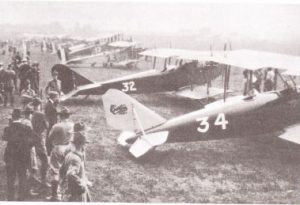 I think most of us have watched car races at some point in our lives, some of us, like my sister Alena Stevens and her husband Mike, have even been to some of the big raceways. Some of us…as teenagers, even participated in drag racing on the public streets, hoping the whole time not to get caught by the police. While these don’t happen every day, they are a normal type of race, but on this day October 8, 1919, a most unusual race was held. It was the first of its kind. The first transcontinental flight took place in 1911, so I suppose that it was only a matter of time before a race had to be held. The first Transcontinental Air Race in the United States took place with 63 airplanes competing in the round trip aerial derby between California and New York.
I think most of us have watched car races at some point in our lives, some of us, like my sister Alena Stevens and her husband Mike, have even been to some of the big raceways. Some of us…as teenagers, even participated in drag racing on the public streets, hoping the whole time not to get caught by the police. While these don’t happen every day, they are a normal type of race, but on this day October 8, 1919, a most unusual race was held. It was the first of its kind. The first transcontinental flight took place in 1911, so I suppose that it was only a matter of time before a race had to be held. The first Transcontinental Air Race in the United States took place with 63 airplanes competing in the round trip aerial derby between California and New York.
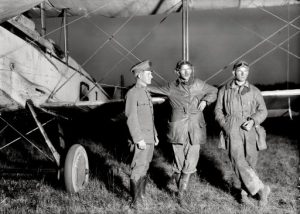
Fifteen planes took off from the Presidio in San Francisco California, and 48 planes left Roosevelt Field on Long Island, New York. The goal was to see who could fly from one location to the other and back with the best time. I know that most of us instinctively look up when we hear an airplane overhead, so just imagine hearing 48 of them flying over at the same time. What an amazing sight that would be. Of course, the planes would eventually spread out some, as the faster ones got ahead of the others. The race was a total of 5,400 miles long, and the winner was Lieutenant Bevin Maynard, who reached Presidio in just over three days rested, serviced his plane and took off again. His actual 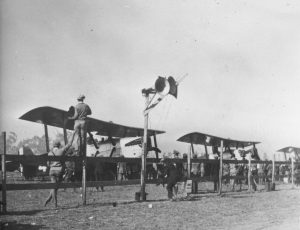 flight time was 24 hours, 59 minutes, and 49 seconds. Maynard won the race by having the lowest elapsed time, even though three other people had faster actual flying times.
flight time was 24 hours, 59 minutes, and 49 seconds. Maynard won the race by having the lowest elapsed time, even though three other people had faster actual flying times.
Since that first race, there have been any others, including a Junior transcontinental air speed record and a Women’s transcontinental air speed record. People just seem to have a natural need for speed, and once a record has been set, someone is always there waiting in the wings to break that record. It seems flight is one of the biggest need for speed and record breaking areas of transportation there is.
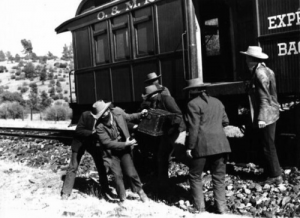 There are people these days who think we should get rid of the police officers, but they are obviously not thinking about the Old West. In the early days of the Old West, there were no law men. People had to take care of themselves. And contrary to what you might think, many people didn’t just carry a gun everywhere then either. That basically left them defenseless in many situations. On this day October 6, 1866, the Reno Gang carried out the first robbery of a moving train in United States history. Prior to that day, trains had been robbed while they were at the stations or in the freight yards, but that was proving to be a little dangerous, as the lawmen that were in the west were mostly in the towns. The Reno Gang changed the way criminals thought about things.
There are people these days who think we should get rid of the police officers, but they are obviously not thinking about the Old West. In the early days of the Old West, there were no law men. People had to take care of themselves. And contrary to what you might think, many people didn’t just carry a gun everywhere then either. That basically left them defenseless in many situations. On this day October 6, 1866, the Reno Gang carried out the first robbery of a moving train in United States history. Prior to that day, trains had been robbed while they were at the stations or in the freight yards, but that was proving to be a little dangerous, as the lawmen that were in the west were mostly in the towns. The Reno Gang changed the way criminals thought about things.
I’m not sure if their plan would have been considered innovative exactly, but as crime goes, I suppose it was. 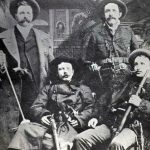 Their idea was that if they robbed the train in some remote area of the track, the crew of the train, and the people on it would be at their mercy, and they could take what they chose to. That first moving train robbery was on an Ohio and Mississippi train in Jackson County, Indiana, and netted the gang a profit of $10,000. It was a piece of cake, because there was no one to save the people on board. While I don’t believe anyone died, they were all very scared.
Their idea was that if they robbed the train in some remote area of the track, the crew of the train, and the people on it would be at their mercy, and they could take what they chose to. That first moving train robbery was on an Ohio and Mississippi train in Jackson County, Indiana, and netted the gang a profit of $10,000. It was a piece of cake, because there was no one to save the people on board. While I don’t believe anyone died, they were all very scared.
The news of this new type of robbery traveled fast, and before long, trains became a moving target. There were gangs, like Butch Cassidy’s Wild Bunch who found train robbery so easy and profitable, that for a time, it became their specialty. The large stashes of cash and precious minerals on the trains and the sparsely populated landscape, gave the gangs just what they needed for success. Nevertheless, like all crime, eventually 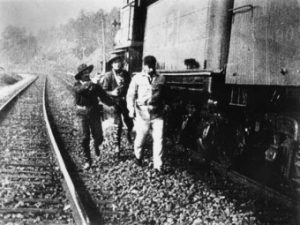 precautions were taken to prevent continued loss. By the late 1800s, robbing trains became increasingly dangerous. Railroad owners started protecting their trains’ valuables with large safes, armed guards, and fortified boxcars.
precautions were taken to prevent continued loss. By the late 1800s, robbing trains became increasingly dangerous. Railroad owners started protecting their trains’ valuables with large safes, armed guards, and fortified boxcars.
The Reno Gang was finally captured in 1868 after a series of robberies. That December saw another type of problem that develops when there is a lack of lawmen…vigilante justice. A mob of the citizens of the town, stormed the jail and hanged the brothers, Frank, Simeon, and William Reno and fellow gang member, Charlie Anderson. Their brother John Reno had been caught earlier and was serving time in a different prison.
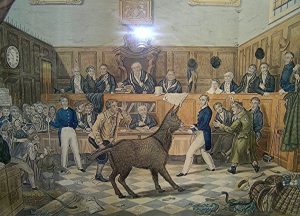 Imagine charging a horse with murder, reckless endangerment, or vandalism for things like bucking its rider off, causing death or injury, or kicking the neighbors fence down. Insane, right…wrong!! For centuries, animals, including insects faced criminal charges across many parts of Europe. Now, I personally think that most insects need to be executed…no trial necessary!! The earliest documented case was a pig, who after being found guilty, was executed at Fontenay-aux-Roses in 1266. At that time it was believed that animals knew right from wrong, like humans do. I don’t think they were far off, because animals do seem to know when they have done something wrong, but I’m not sure that they understand guilt over of an accidental death or injury.
Imagine charging a horse with murder, reckless endangerment, or vandalism for things like bucking its rider off, causing death or injury, or kicking the neighbors fence down. Insane, right…wrong!! For centuries, animals, including insects faced criminal charges across many parts of Europe. Now, I personally think that most insects need to be executed…no trial necessary!! The earliest documented case was a pig, who after being found guilty, was executed at Fontenay-aux-Roses in 1266. At that time it was believed that animals knew right from wrong, like humans do. I don’t think they were far off, because animals do seem to know when they have done something wrong, but I’m not sure that they understand guilt over of an accidental death or injury.
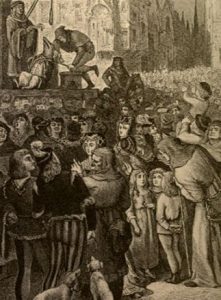
Nevertheless, these trials went on as part of several legal systems until the 18th century. Animal defendants appeared before both church and secular courts, and the charges ranged from murder to criminal damage. Human witnesses were often heard and in Ecclesiastical courts the animals were routinely provided with lawyers. If convicted, the animal was usually executed or exiled. Several books were written about these trials. E.P. Evans’ The Criminal Prosecution and Capital Punishment of Animals, published in 1906, and Sadakat Kadri’s The Trial: Four Thousand Years of Courtroom Drama were two such books. Kadri shows that the trials were part of a broader phenomenon that saw corpses and inanimate objects also face prosecution…which takes weird to a completely new level. Some people think that modern day punishment of children and the mentally ill is rather an echo of those strange earlier rituals.
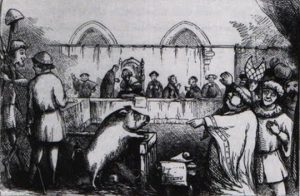
Several thoughts have come to my mind concerning these animal trials. For instance, animals can’t talk, so how were they supposed to testify or speak in their own defense? Also, were these trials held in a courtroom or a stable…for obvious reasons? And, if the offending animal belonged to someone, not the person who was the victim, how were they compensated for the loss of their animal? After all, they didn’t commit the “crime” that their animal was accused of. This is such a strange practice, that I have to wonder who came up with the idea originally anyway, and were they sane…or more likely insane.
 We’ve all eaten them…unless you are allergic to chicken that is. Hot wings. They grace just about every Super Bowl party food table, or any other football gathering for that matter, but where did the idea come from? Well, they have been around longer than I thought they had. I think that many people used the chicken wings for soup stock, and some restaurants even threw it away. Now my husband likes the wings, but much of the time, I find them a waste of time, unless they are in the form of hot wings. I think a lot of people would agree with my point of view.
We’ve all eaten them…unless you are allergic to chicken that is. Hot wings. They grace just about every Super Bowl party food table, or any other football gathering for that matter, but where did the idea come from? Well, they have been around longer than I thought they had. I think that many people used the chicken wings for soup stock, and some restaurants even threw it away. Now my husband likes the wings, but much of the time, I find them a waste of time, unless they are in the form of hot wings. I think a lot of people would agree with my point of view.
Accounts of the invention of hot wings, or Buffalo Wings as they are often called, vary, but apparently the one that has been most accepted is that they were invented by Teressa Bellissimo, who along with her husband Frank, owned the Anchor Bar in Buffalo, New York. When the Bellissmo’s son, Dominic made a surprise visit from college with several friends, Teressa needed a fast and easy snack to present to all of her guests. It was then that she came up with the idea of deep frying chicken wings and tossing them in cayenne hot sauce. Apparently, the wings were a big hit. However, when a long article was written about the Anchor Bar, no mention was made of the Buffalo Wings.
 Another man, John Young also claims to have made the first Buffalo Wings covered in a special Mambo Sauce in his Buffalo restaurant in the 1960s. Young’s wings were breaded, unlike the hot wings of today. Young registered his restaurant as John Young’s Wings ‘n Things, at the county courthouse in Buffalo before leaving the area in 1970. The Bellissimo family claims that the Young Buffalo Wings used the same sauce as the Bellissimo Buffalo Wings. I suppose it really doesn’t matter who invented them, or what sauce is used, especially since there are multiple flavors now. The main thing is that pretty much everyone has had and loves Buffalo Wings. In fact, they have become a party mainstay since the 1960s.
Another man, John Young also claims to have made the first Buffalo Wings covered in a special Mambo Sauce in his Buffalo restaurant in the 1960s. Young’s wings were breaded, unlike the hot wings of today. Young registered his restaurant as John Young’s Wings ‘n Things, at the county courthouse in Buffalo before leaving the area in 1970. The Bellissimo family claims that the Young Buffalo Wings used the same sauce as the Bellissimo Buffalo Wings. I suppose it really doesn’t matter who invented them, or what sauce is used, especially since there are multiple flavors now. The main thing is that pretty much everyone has had and loves Buffalo Wings. In fact, they have become a party mainstay since the 1960s.

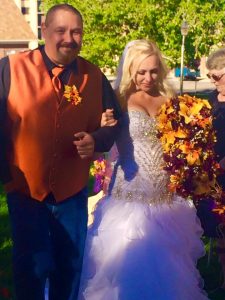 Every bride-to-be dreams of a perfect wedding day. Yesterday, that dream came true for my grand niece, Katy Balcerzak, when she married her soul mate, Jacob Collett. Their outdoor wedding was given a perfect sunny day, and the fall colors that were the theme of the wedding gave a beautiful brightness to the entire park. The sun shone brightly, and the day was warm…especially for fall, like Indian Summer, perfect. Katy and Jake have been soul mates for some time now, and the next logical step was to unite in marriage. The planning took a number of months, but it was well worth it when the day finally arrived. Katy was the bride with her perfect wedding day. Every aspect of her special day, with her special man, Jake was a perfect as it could be.
Every bride-to-be dreams of a perfect wedding day. Yesterday, that dream came true for my grand niece, Katy Balcerzak, when she married her soul mate, Jacob Collett. Their outdoor wedding was given a perfect sunny day, and the fall colors that were the theme of the wedding gave a beautiful brightness to the entire park. The sun shone brightly, and the day was warm…especially for fall, like Indian Summer, perfect. Katy and Jake have been soul mates for some time now, and the next logical step was to unite in marriage. The planning took a number of months, but it was well worth it when the day finally arrived. Katy was the bride with her perfect wedding day. Every aspect of her special day, with her special man, Jake was a perfect as it could be.


Katy is the youngest child of my niece, Chantel Balcerzak’s husband Dave. She was just a teeny little girl, the first time I met her. I remember just how much she loved her daddy, and just how cute she was. It was a picnic on the mountain, and we all had a wonderful time. Katy, and Chantel’s daughter, Siara Harman were great friends, and in fact, Siara was one of Katy’s bridesmaids on her special day. The position of man of honor, however fell to Katy’s best friend…her brother, Kiefer. Katy, along with her brother, Kiefer were a great addition to Chantel’s blended family with Dave. Chantel’s son Jake Harman, rounded out the four blended siblings. Now Katy, like all the other kids, is all grown up, and ready to start the next 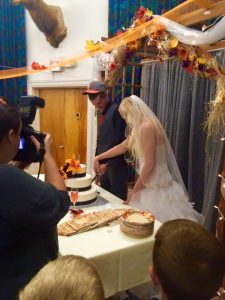
 turn in life’s road…marriage. This is a journey, Katy and Jake have been planning on and looking forward to for a long time.
turn in life’s road…marriage. This is a journey, Katy and Jake have been planning on and looking forward to for a long time.
Her journey through a life of love is just beginning, and oh what a beginning it was. The reception was as beautiful as the wedding. Katy loves pumpkins, and really pretty much everything about the month of October. No wonder she chose that month for her wedding. Of course, Katy and Jake also love outdoor sports, and so the grooms cake had to be a truck…didn’t it? It wouldn’t have been Katy and Jake without it. Jake, welcome to the family. We wish both Katy and Jake a long and happy life. Congratulations to both of you!!
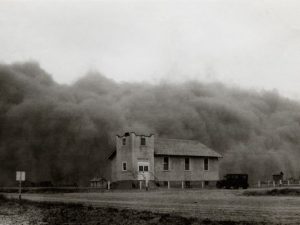
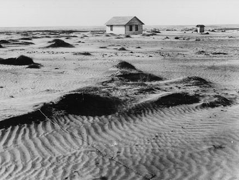 Drought…anywhere and at any time, is a perilous situation. Crops can’t grow, and food prices go up. But when a drought happens in the middle of an economic depression, it is catastrophic. The Dust Bowl, which was also known as the Dirty Thirties, was a period of severe dust storms during the 1930s. Mistakes were made during this drought…mistakes like a failure to implement dryland farming methods to prevent wind erosion caused the Dust Bowl. The drought came in three waves…1934, 1936, and 1939–40, but some regions of the high plains experienced drought conditions for as many as eight years. The people had no real understanding of the ecology of the plains. The farmers had plowed deep into the virgin topsoil of the Great Plains during the previous decade. This displacement of the native, deep-rooted grasses that normally trapped soil and moisture even during periods of drought and high winds were gone. During the drought of the 1930s, the unanchored soil turned to dust, which the prevailing winds blew away in huge clouds that sometimes blackened the sky. These choking clouds of dust…named “black blizzards” or “black rollers” traveled cross country. The Dust Bowl forced tens of thousands of families to abandon their farms.
Drought…anywhere and at any time, is a perilous situation. Crops can’t grow, and food prices go up. But when a drought happens in the middle of an economic depression, it is catastrophic. The Dust Bowl, which was also known as the Dirty Thirties, was a period of severe dust storms during the 1930s. Mistakes were made during this drought…mistakes like a failure to implement dryland farming methods to prevent wind erosion caused the Dust Bowl. The drought came in three waves…1934, 1936, and 1939–40, but some regions of the high plains experienced drought conditions for as many as eight years. The people had no real understanding of the ecology of the plains. The farmers had plowed deep into the virgin topsoil of the Great Plains during the previous decade. This displacement of the native, deep-rooted grasses that normally trapped soil and moisture even during periods of drought and high winds were gone. During the drought of the 1930s, the unanchored soil turned to dust, which the prevailing winds blew away in huge clouds that sometimes blackened the sky. These choking clouds of dust…named “black blizzards” or “black rollers” traveled cross country. The Dust Bowl forced tens of thousands of families to abandon their farms.
The drought, along with the already depressed economy, caused many people to have very little money. It was during this time that people had to get creative to meet their needs. Enter the flour sack…say what!! Yes, the flour sack. When the people didn’t have money for fabric to make clothing, they began to use the cloth flour sacks as material for clothing. Then, some industrious flour distributor somewhere decided to assist the people. The flour sacks began to have pretty designs on them. Just because the people were going to use the sacks for clothing, didn’t mean that they had to look like they were wearing a flour sack. It didn’t matter that everyone knew it was a flour sack either. It looked pretty, and that really helped with morale. In reality, cloth is cloth, but I suppose the flour sacks were not of the normal dress quality. Still, when that was all you had, you did what you had to do. When you are given lemons, make lemonade, and all…right.
As the flour sacks began to be prettier, the dresses became quite fashionable, and looking back on some of the dresses that were made, I doubt that most people would know the difference between a flour sack dress and any other dress…had they not been told. The people of those times really got quite creative in meeting the 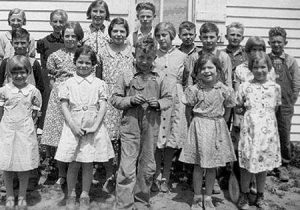
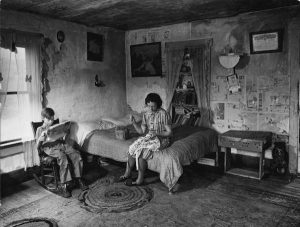 needs of the family…clothing, furniture, or even their houses…people persevered. Of course, food was a little bit more difficult in those days, because if the crops wouldn’t grow, you simply had to find something else to eat. I’m sure there were a lot of people who were pretty skinny in those days…as well as pretty hungry. Nevertheless, with the help of creative mothers, and industrious flour distributors, the girls looked very nice, and quite fashionable.
needs of the family…clothing, furniture, or even their houses…people persevered. Of course, food was a little bit more difficult in those days, because if the crops wouldn’t grow, you simply had to find something else to eat. I’m sure there were a lot of people who were pretty skinny in those days…as well as pretty hungry. Nevertheless, with the help of creative mothers, and industrious flour distributors, the girls looked very nice, and quite fashionable.
 Anytime a soldier goes to war, there is a possibility of that soldier not returning, but some MOS (Military Occupational Specialty) categories were more dangerous than others. The life expectancy of a ball turret gunner in World War II, for instance, was just 12 minutes…yes, that’s right…12 minutes. And these guys didn’t always have a choice as to what job they did. If they were the shortest, they were most likely going to be a ball turret gunner, because of limited space in the ball. Still, while I don’t know the exact number who died, I know it was quite a few. Of course, soldiers on the ground are more at risk than other occupations too. There were the suicide bombers from Japan, who chose to fly their plane right into a ship too, but I think that few occupations were as deadly as that of the U-Boat crew. It wasn’t so much that the occupation was deadly, but rather that every country in the world was after the German U-Boat.
Anytime a soldier goes to war, there is a possibility of that soldier not returning, but some MOS (Military Occupational Specialty) categories were more dangerous than others. The life expectancy of a ball turret gunner in World War II, for instance, was just 12 minutes…yes, that’s right…12 minutes. And these guys didn’t always have a choice as to what job they did. If they were the shortest, they were most likely going to be a ball turret gunner, because of limited space in the ball. Still, while I don’t know the exact number who died, I know it was quite a few. Of course, soldiers on the ground are more at risk than other occupations too. There were the suicide bombers from Japan, who chose to fly their plane right into a ship too, but I think that few occupations were as deadly as that of the U-Boat crew. It wasn’t so much that the occupation was deadly, but rather that every country in the world was after the German U-Boat.
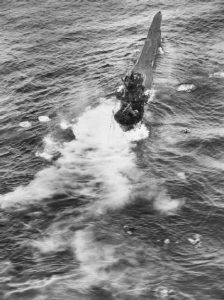
The U-Boat was a German submarine, and they were the best sumbarine the Germans had. There were 40,000 men who were assigned to the German U-Boats during World War II. Of those assigned to the U-Boats, only 10,000 returned. That is a shocking number!! I would never have wanted the Germans to win World War II, but when I think of the soldiers who fought, I’m sure that there were many who disagreed with Hitler, and others who were brainwashed into following him, but they were still soldiers, and people, and they had been given an assignment that was going to most likely get them killed. You see, the German U-Boat was the most feared of all the ships or submarines during World War II. They had a code system that was hard to crack, and they were sinking the Allies ships. They had to go. Once the Allies figured out their code, they could no longer hide. The U-Boats began dropping like flies, and with them…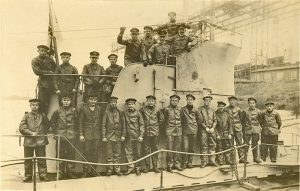 their crews, of course.
their crews, of course.
The U-Boats ran on battery power when they were submerged, and that didn’t last very long. So they were required to be a surface vessel most of the time, operating on their diesel engines. I don’t think that contributed to the U-Boat becoming a target, because as long as their whereabouts was coded, they were relatively safe. Once that safety net was gone, they were in a lot of trouble, as has been proven by the number of casualties. The fate of the crews of the U-Boats was not a good one, and those 30,000 men paid the final price, once that safety net was gone.

